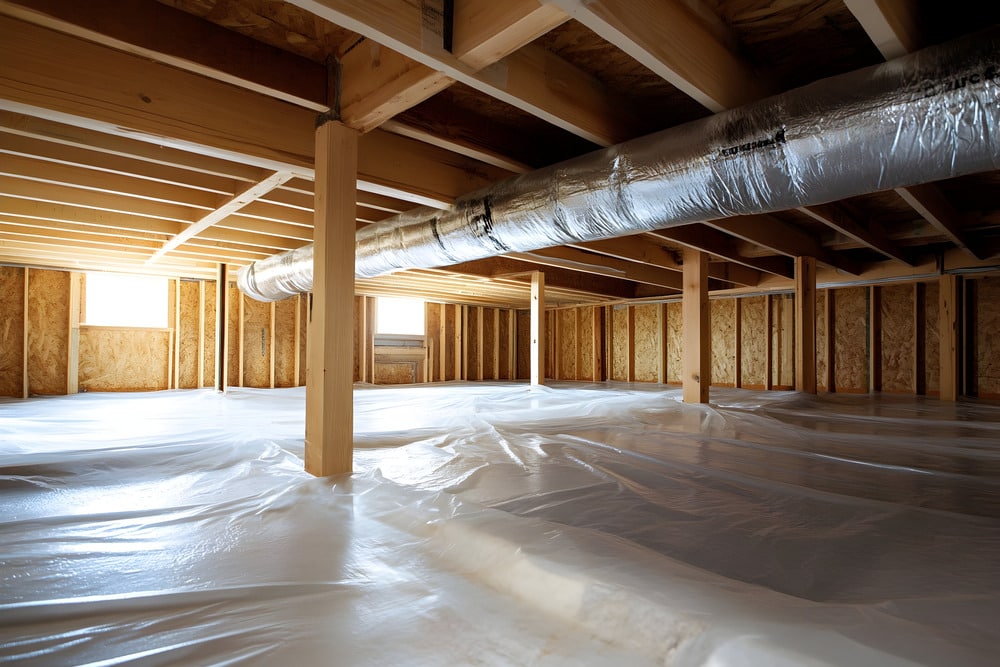
Crawl spaces are essential areas that may house your home’s heating, cooling, plumbing, and electrical systems. Without proper insulation, these spaces allow outside air and moisture to enter your home freely. This can create problems like cold floors, higher energy bills, and potential damage to your house’s structure. This guide explains what crawl space insulation is, how it works, the available types, and signs that your crawl space needs proper insulation.
What Is Crawl Space Insulation?
Crawl space insulation is material placed in the walls of your crawl space to manage the temperature. Insulation slows down the movement of air in your crawl space, trapping the air inside and making it easier to maintain a consistent temperature. When you hire professional contractors, they typically remove old materials before adding new insulation to ensure proper installation.
What Parts of the Crawl Space Are Insulated?
The specific areas receiving insulation treatment vary based on your crawl space design and ventilation. Here are the main parts that get insulated:
- Foundation walls get insulation materials applied to the interior surfaces
- Floor areas are covered with a vapor barrier
- Rim joist spaces receive a foam application to seal gaps
- Floor and wall joints are sealed to stop airflow
- Insulation is placed between floor joists
- Plumbing lines are covered with protective insulation materials
Why Crawl Space Insulation Is Important
Your crawl space plays an important role in your home’s overall health, affecting everything from energy costs to indoor comfort. Adding insulation to this area provides the following benefits:
Energy Efficiency
Your HVAC system struggles to maintain comfortable temperatures in your home when your crawl space isn’t insulated, which means higher electricity and gas bills each month. Cold air enters through the crawl space during winter and makes the floors chilly, which forces your heating system to work harder. During the summer, hot air from below makes your cooling system run constantly to keep your home comfortable. Adding crawl space insulation creates a thermal barrier that helps your HVAC equipment operate more efficiently while reducing monthly energy expenses.
Moisture and Mold Control
Wet crawl spaces are breeding areas for harmful mold spores that can find their way into your living spaces through air circulation. They damage wooden structural components while presenting health risks to family members who have allergies or breathing problems. Crawl space insulation materials work in conjunction with vapor barriers to maintain low moisture levels and prevent the growth of mold.
Structural Protection
Extreme cold can freeze the pipes in your crawl space, causing them to burst and flood your home. Temperature changes also cause wooden beams to expand during heat and shrink during cold weather, which gradually weakens the structural integrity of your crawl space. Insulation maintains steady temperatures, protecting your plumbing from freezing while ensuring your home’s structure remains safe. This protection helps you avoid costly repairs and keeps your foundation stable for years to come.
Comfort and Indoor Air Quality
Air naturally circulates from your crawl space into the rest of your home, carrying dust, allergens, and outdoor pollutants into rooms where your family spends time. Proper insulation blocks these contaminants from entering your home and keeps air quality fresh year-round.
How Crawl Space Insulation Works
Here is how crawl space insulation works to protect your home:
Sealing vs. Insulating
Sealing focuses on blocking unwanted air circulation by filling cracks and gaps in your crawl space. It prevents your heated or cooled air from escaping while stopping pesky outside air from sneaking in. Insulation tackles a different problem by creating a thermal barrier that slows down heat movement through building materials. When homeowners use both air sealing and insulation methods together, they typically see lower energy bills, along with more consistent room temperatures, quieter indoor spaces, and better air quality.
Types of Crawl Space Insulation
Here are the main crawl space insulation options that you can consider when upgrading your home’s thermal protection system.
Rigid Foam Board Insulation
Rigid foam boards offer a sturdy solution that homeowners can attach directly to crawl space walls. These heavy-duty boards come in standard sizes that you can cut to fit around pipes and electrical components. The material creates a solid barrier that does a great job of stopping heat transfer and moisture intrusion. You only need basic tools and adhesive for installation, so it’s a good choice for many do-it-yourself projects.
Spray Foam Insulation
Professional installers use specialized equipment to apply spray foam insulation that expands into every crack and corner of your crawl space. The expanding action ensures complete coverage in irregular spaces where other materials might leave gaps. Once the foam hardens, it forms a permanent seal that won’t shift or settle over time. This material has excellent air sealing properties but needs proper ventilation during application. The cost is higher than other options, but the superior performance often justifies the investment.
Fiberglass Batt Insulation
Fiberglass batts are a soft, blanket-like material made from spun glass fibers that homeowners can install themselves. These batts offer the lowest upfront cost among all insulation choices available to homeowners. Unfortunately, the fibrous material absorbs moisture easily, resulting in mold and mildew growth and reduced insulating power. The soft texture may also attract pests looking for nesting areas. This solution typically requires replacement after approximately 15 years of use.
Installation: Vented vs. Unvented Crawl Spaces
Crawl spaces fall into two categories based on their airflow design. Each category needs its own specific insulation strategy to work properly.
Insulating a Vented Crawl Space
Openings in a vented crawl space allow outside air to circulate through the space beneath your home. Unfortunately, during humid weather, this airflow frequently causes moisture issues. When warm air enters and hits cool surfaces, it creates water droplets that can damage wood and encourage mold growth. Before adding any insulation materials, begin the installation by removing all debris and checking the area for any damage. Choose foam insulation that resists water absorption and install it between the wooden floor supports overhead, then cover the ground with thick plastic sheeting to block moisture coming up from the soil.
Insulating an Unvented (Encapsulated) Crawl Space
Sealed crawl spaces have no vents and stay completely closed off from outdoor air circulation. Apply insulation materials directly onto the foundation walls using either spray application or rigid panels attached with screws and adhesive. You must cover the entire floor area with heavy plastic that extends partway up the walls, then seal every joint with waterproof sealing material to create one continuous moisture barrier.
Signs Your Crawl Space Needs Insulation
Several signs point to the need for insulation beneath your home, such as:
- Cold floors in winter: Nobody wants to walk on icy floors inside their house. When your feet get cold just from walking around during winter, warm air is escaping through the space below.
- Musty smells: That weird, damp smell that keeps returning means water is getting trapped under your house. Proper insulation stops this moisture buildup that leads to these smells.
- Visible mold or mildew: Any type of mold is a sign that there may be high water levels in your crawl space. This happens when temperature and moisture are not properly controlled.
- High indoor humidity levels: When your rooms stay humid even with the AC on, insufficient crawl space insulation is allowing moisture to enter your living area.
- Wobbly or sinking floors: If your floors creak, sag, or slope, water damage might have weakened the wooden beams underneath due to poor moisture management.
Common Mistakes to Avoid With Crawl Space Insulation
Here are the common mistakes to avoid in your crawl space insulation project:
- Forgetting to seal air leaks first: Many homeowners rush to install insulation without plugging holes and cracks. Air keeps moving through these openings, which lets heat escape and moisture get in. Your energy bills stay high because the insulation can’t do its job properly.
- Picking the wrong insulation type: Not all insulation works the same in every space. Using the wrong material for your crawl space can lead to poor results. Fiberglass batts often fail in tight crawl spaces because they don’t seal well and can hold moisture.
- Leaving gaps: Missing even small areas leaves spaces for heat to flow freely. These gaps are likely to appear around pipes, corners, and tight spaces. Your overall insulation system becomes less effective when coverage isn’t complete.
- Skipping moisture protection: Crawl spaces naturally collect moisture, but many people install insulation without fixing dampness issues first. This trapped moisture damages wood, creates mold, and ruins the insulation over time.
- Ignoring building codes: There are building codes in every area for how to install crawl space insulation. Working with experienced contractors like KC Waterproofing and Foundation Repair ensures your project meets all local standards from the start.
FAQs
Is insulation alone enough, or do I need encapsulation too?
You need both for the best results. This is because insulation controls temperature while encapsulation handles moisture and humidity.
How much does crawl space insulation cost?
The cost of crawl space insulation varies based on crawl space size, material type, the labor involved, any prep work, the location, and old material that needs to be removed. Get a free customized quote from our team to determine the cost of insulating your crawl space.
Will insulating my crawl space make my home more energy efficient?
Yes, insulation creates a barrier that keeps heat from going out during winter and entering in summer. This saves you money on your energy bills and makes your home more comfortable throughout the year. You’ll also notice improved air quality, as good insulation helps prevent moisture-related problems.
Can I install crawl space insulation myself?
DIY installation is possible but involves working in cramped spaces with safety risks. Professional work prevents moisture issues and structural problems that can be expensive to repair. At KC Waterproofing and Foundation Repair, we provide comprehensive crawl space repairs to keep your home well-protected.










